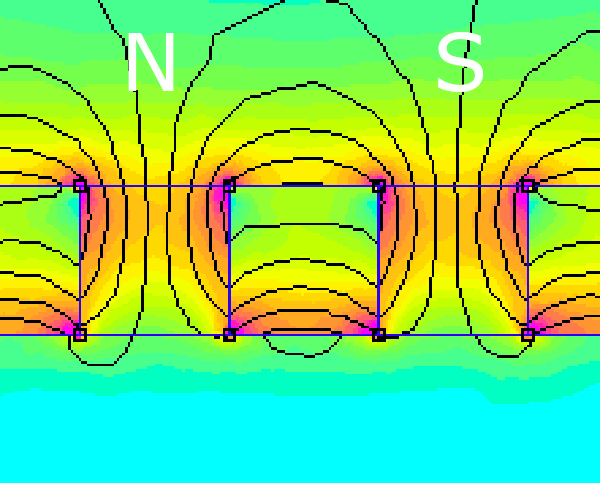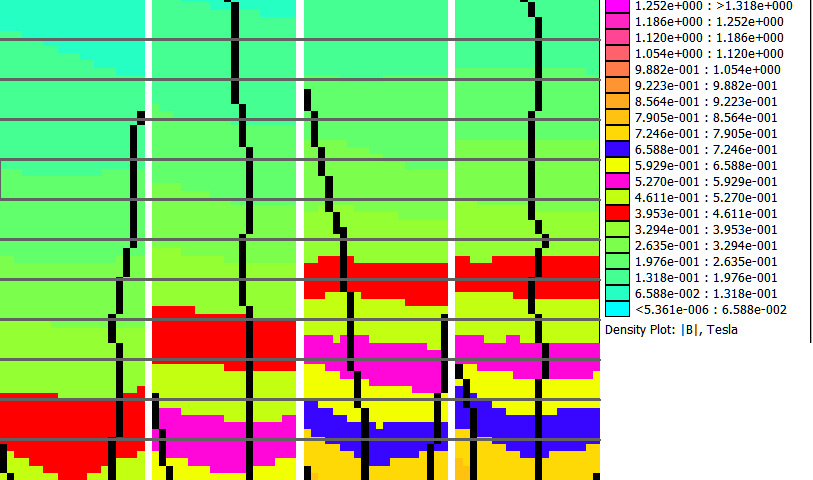I would like to build a strong magnet using 100 6"x4"x1" permanent magnet blocks. What is the best way to place them so I get the strongest magnetic field? (Should I stack 2 rows of 50 blocks and put them side by side? Should I place them like a Halbach array?...) I use this magnet to attract metal particles that are on a conveyor. The field must attract the medium-sized particles (2"x3"x2" approx.) upon a fairly good distance.
-
$\begingroup$ You answered your own question writing about Hallbach array, aren't you? $\endgroup$– HolgerFiedlerCommented Jun 17, 2016 at 17:34
-
$\begingroup$ You are going at this the exact wrong way. In engineering we don't start with "I have six brick, now how do I build a house?" but with "I want to build a house, how many bricks do I need?". The correct procedure here is experimental. Use one or a few of your magnets to measure the area in which they attract exactly the kinds of parts that you want, then scale it up. Using magnets alone, without a proper magnetic return path is not going to get you a good magnet, anyway, though. $\endgroup$– CuriousOneCommented Jun 17, 2016 at 18:31
-
$\begingroup$ If you tie these magnets parallel to each other such that all the north are facing one direction you would likely to have a strong attracting force. It is just my gut feeling, in any case field very close to magnet pole remain same as of one magnet. $\endgroup$– hsinghalCommented Jun 17, 2016 at 19:20
-
$\begingroup$ Ok thank you I'll make some your tests monday and I will come back with the results! $\endgroup$– Jean-Gabriel Deshaies MorinCommented Jun 17, 2016 at 20:23
2 Answers
The permanent magnets are magnetic dipoles which means that their field goes down like $B\sim 1/r^3$ with the distance from the dipole. The number of such magnets in a volume goes like $r^3$, so regardless of the value of $r$, the magnetic field will have basically the same magnitude.
In particular, if you just double all the dimensions, the whole "picture" will just magnify but the magnitude of the magnetic fields at the corresponding points will stay the same.
Moreover, the magnetic field right at the top of each magnet will be the same regardless of the arrangement. There's basically no way to increase the magnetic field by combining many magnets. Different arrangements will produce different shapes of the magnetic field. One can make the field stronger above the magnets but a bit weaker on the sides, or vice versa, but you would have to describe exactly which quantity of the magnetic field you want to be maximized.
-
$\begingroup$ The place where I want the strongest magnetic field is the side parallel to the conveyor(seen as the bottom), so the particles get attracted. The four sides and the top are not important at all. Thank you $\endgroup$ Commented Jun 17, 2016 at 17:25
-
1$\begingroup$ This is a cleverly simple answer without much math, very nice! Luckily we have iron. $\endgroup$– uhohCommented Oct 30, 2016 at 11:56
This is waaaay late, but I've been examining the question of how to maximise magnetic field for the amount of magnetic material used and I had the following findings. So far I've been examining arrays where one side is used, similar to the one for your production line.
First a femm model of pair of N40 neodymium magnet poles in air for a baseline. The magnets are 2cm by one cm thick and one inch deep.
Note that your strongest field in air is at the edge between the poles, so with this configuration you'd want this seam to be across your belt so all product passed below that point.
Next a model of the same pair of magnet poles with an iron back. You can see this slightly strengthens the field on the front.
Note that the iron back is rather thick and nonetheless saturated, so getting front side field improvements this way takes a lot of iron.
Next a model of a pair of halbach array poles in air. You can see the front side field is much stronger than even the magnets backed by iron.
Finally a halbach array with an iron back. You can see because much less of the magnetic circuits are on the back, little iron is actually used and the improvement in front side field is small.
Then why don't we look at a side by side comparison in the same order to see better how much stronger the fields are at pole center(More relevant to rotary machine design but I'll put it in here since it's made):
So this is zoomed in on the air directly in front of the poles, with lines added for millimeters of distance from the magnet. You can see that the halbach array produces a similar field to the iron backed traditional array an additional 2 mm out from the face of the magnet. You can also see that the improvement from adding iron to the halbach array is fairly small.
As a final note, you're using rather large and strong magnets, and magnets push against being forced into a halbach configuration, so you'll probably have to be very careful in how you assemble the finished array.





